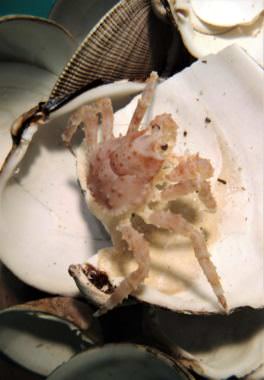
In the Pribilof Islands, no one’s gotten an accurate count of blue king crab since the population crashed hard in the 1980s. This summer, a marine biologist is trying to change that, with the species’ first in-depth study in more than 30 years. His ultimate goal: determine if blue crab can make a comeback — or if it’s gone for good.
It’s a foggy day on St. Paul Island and Jared Weems is itching for the weather to clear up. He wanted to get out on the water and back to work.
“There’s so much life up here in the North Pacific,” Weems said. “Just amazing, spectacular diving.”
Weems is a scientific diver and fisheries Ph.D. student at the University of Alaska Fairbanks. But this summer, whenever the weather’s good, he’s something like a diving detective.
Weems’ research has him combing the sea floor around St. Paul, searching for the elusive blue king crab. By diving in nearshore waters, deploying drop cameras and setting collector traps, he’s hoping to find the crab that sweeping trawl surveys tend to miss.

At this point Weems said it’s important to count as many as possible, because the species’ outlook seems pretty bleak.
“Blue crab has pretty much flat-lined right now in the Pribilof region,” Weems said.
But the population around St. Matthew Island, a few hundred miles north, had a similar collapse before rebounding enough to support a handful of commercial openings in recent years.
Is that a sign the Pribilof stock could also recover? Weems isn’t sure yet. He’ll have a better idea after he completes his population estimate — when he knows how many crab are in the water, how many are surviving to adulthood, and how much habitat they have to work with.
With that data, Weems said he’ll gauge if the blue crab population can rebuild naturally, if it needs some help from scientists or if there’s just not enough stock to rebuild.
Whatever the final answer may be, Weems said now is the time to take advantage of each clear day.
“This might be one of the last opportunities to really understand this stock before we have to move on or before it’s gone completely,” Weems said. “This should serve as a foundational study as to where blue king crab goes in the future.”
The preliminary results will be out in January with final data released in 2019.
Weems’ project is supported by The North Pacific Research Board, the Aleut Community of St. Paul Island, the Central Bering Sea Fishermen’s Association, the Bering Sea Fisheries Research Foundation, the National Oceanic and Atmospheric Association, the University of Alaska Fairbanks and the Alaska King Crab Research, Rehabilitation, and Biology Program.
Laura Kraegel covers Unalaska and the Aleutian Islands for KUCB . Originally from Chicago, she first came to Alaska to work at KNOM, reporting on Nome and the Bering Strait Region. (laura@kucb.org / 907.581.6700)




